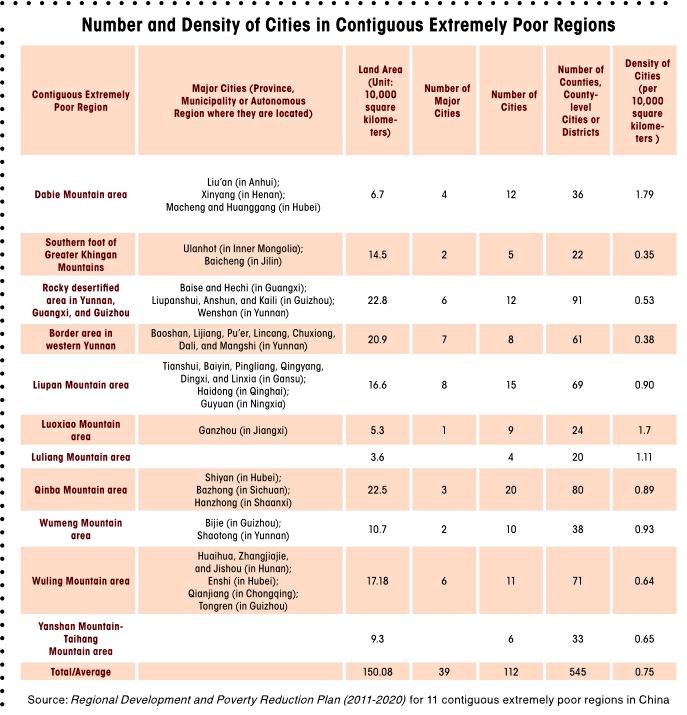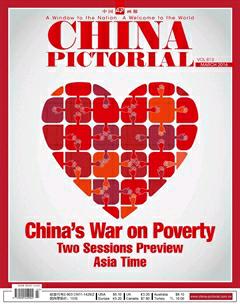China’s War on Poverty:Challenges and Experiences
by+Zuo+Changsheng
Poverty is a common challenge facing the entire world, and ending poverty is a common goal of all mankind. The Communist Party of China (CPC) and the Chinese government consider poverty reduction their historic mission and duty. After 37 years of efforts since its implementation of the reform and opening-up policies, China has successfully lifted more than 700 million of its rural population out of poverty – a number greater than any other country. China was also the first country to complete poverty reduction objectives of the United Nations (UN) Millennium Development Goals.
Facing the future, China set the Two Centenary Goals. The first is to build a moderately prosperous society in all aspects and double the 2010 GDP and per capita income of residents in both rural and urban areas by 2020. The goal of completing the construction of a moderately prosperous society in all aspects will not be fulfilled unless poverty-stricken areas achieve a comprehensively healthy society and impoverished people climb towards prosperity. Therefore, poverty is the biggest roadblock for China to overcome to fulfill the task of building a moderately prosperous society. The Chinese government attaches great importance to poverty reduction, aiming to lift all of its population out of poverty within the 13th Five-Year Plan period (2016-2020).
Objectives and Challenges
Chinas objective in poverty reduction for the 13th Five-Year Plan period is to see all people have adequate food and closing, compulsory education, basic medical care and housing by 2020. The country aims to see the per capita net income growth rate of poor farmers eclipse the national average, and leading indicators of basic public services match the national average. The entire impoverished rural population will be lifted above the current poverty line, and 832 state-class poverty-stricken counties will emerge from the affliction, eliminating overall regional poverty. However, China faces many challenges ahead:
Time is urgent. By the end of 2015, China still had 14 contiguous extremely poor regions, 832 poverty-stricken counties, 129,000 poverty-stricken villages, and more than 60 million rural residents living under the poverty line. To achieve the 2020 objective, the country needs to lift more than 10 million people out of poverty annually over the next five years, which is a daunting task. Over past decades, some areas and people with better conditions to shake off poverty have been lifted out of poverty. Those who remain stuck in poverty usually lack the capacity for selfdevelopment. It is more costly and difficult to lift those people out of poverty.
The causes of poverty are complicated, and it is hard to eliminate. Due to the impact of historical, natural and social factors, it is difficult to lift Chinas current poverty-stricken areas and population out of poverty. Today, the majority of impoverished Chinese people live in 14 contiguous extremely poor regions that feature harsh living conditions, fragile ecological environments, poor infrastructure, and underdeveloped public services. A large proportion of those people are impoverished due to illness, educational costs, and physical disabilities. It is common for those who just manage to obtain adequate food and clothing to fall into poverty again because of natural disasters and diseases.
The “new normal” of the Chinese economy is hindering impoverished people from finding employment and increasing their incomes. After more than three decades of rapid growth, Chinas economy has entered a “new normal” period. In this context, the nation faces new challenges in stabilizing economic growth, transforming growth modes, adjusting economic structures, and preventing risk. With the nation suffering a worsening economic downturn, impoverished people have the hardest time finding and improving employment. Some rural residents fall back into poverty after losing their jobs.
Finally, poverty reduction mechanisms and policies need to be improved. Various government departments have been charged with formulating policies related to poverty reduction, but they lack coordination and have not formed a joint force to fight poverty. Financial policies are incompatible and cannot meet the demands of precision poverty reduction. Moreover, poverty relief mechanisms need to be improved, and there is a lack of effective, reliable social poverty alleviation platforms.
Policies and Measures
To fulfill the 2020 objective in poverty reduction, the Chinese government has formulated polices to promote precision poverty alleviation by strengthening leadership and coordination.
First, clarify responsibility and strengthen leadership. The central government is responsible for formulating major strategies and policies concerning development-oriented poverty reduction; provincial governments are responsible for setting objectives and tasks and raising funds as well as mobilization, supervision, and reporting of poverty relief projects. Municipal governments are responsible for coordinating work from upper and lower levels, as well as supervi- sion and inspection of relevant poverty reduction projects. Countylevel governments are responsible for implementing poverty reduction projects and formulating specialized policies.
Second, coordinate all sectors to form a joint force. A consulting and coordinating organ under the State Council of China, the State Council Leading Group of Poverty Alleviation and Development is responsible for coordinating 46 government departments including the Ministry of Finance, the Ministry of Agriculture, the Peoples Bank of China, the Ministry of Education, and the Ministry of Science and Technology to jointly formulate poverty reduction plans. Through measures like targeted poverty relief and east-west coordination, the government, enterprises, universities, and social organizations are joining hands to fight poverty. Adhering to principles of self-development, China gives full play to poverty-stricken areas and their residents enthusiasm, initiative, and creativity, so that they can play a lead role in poverty reduction.
Third, formulate poverty reduction plans. China has formulated a poverty reduction plan for the 13th Five-Year Plan period.The central government and local governments have incorporated poverty reduction into their respective overall development plans for the 13th Five-Year Plan period. Relevant government departments have also listed poverty reduction as a key project in their respective 13th Five-Year Plans. The government will increase investment in poverty reduction and improve infrastructure in poverty-stricken areas to break development bottlenecks and ignite the overall development of impoverished areas.
Finally, implement precision poverty reduction for different categories of poverty-stricken areas and households. The precision poverty reduction strategy is a major innovation in Chinas development-oriented poverty alleviation drive. Through precise identification of poverty relief targets, precise arrangement of projects, precise allocation of funds, precise policies for each household, precise appointment of poverty relief officials for each village, and precise effectiveness of poverty reduction projects, China has greatly promoted scientific and targeted poverty reduction while avoiding problems such as murky statistics on impoverished population, poorly targeted poverty alleviation projects, and blind use of funds.
Strengthening International Cooperation
The Chinese government has attached great importance to international cooperation in poverty reduction. Through carrying out various kinds of international cooperation, China has learned advanced concepts and lessons from the experiences of foreign countries poverty alleviation efforts and constantly improved its own policies and practices in promoting domestic poverty relief. China also cooperates with other developing countries to carry out intergovernmental dialogues, personnel training, and pilot programs and exchange experience in poverty alleviation, which not only helps relevant countries reduce poverty but also deepens people-topeople friendship. Over the past six decades, China has contributed aid of nearly 400 billion yuan to 166 countries and international organizations. It has exempted due zero-interest loans owed by heavily-indebted poor countries and least developed countries seven times. Moreover, China has provided medical assistance to 69 countries in Asia, Africa, Latin America and offered help to more than 120 developing countries to achieve the Millennium Development Goals.

In recent years, the Chinese government has enacted significant measures to further promote international cooperation in poverty reduction and development. In 2014, China and the African Union co-issued Outline on Strengthening Poverty Reduction Cooperation between China and the African Union, and China and Africa reached consensuses related to promoting poverty reduction, addressing poverty, improving infrastructure, enhancing cooperation in vocational and technical education, training of poverty reduction specialists, and strengthening the demonstration of agricultural technologies. In 2015, the China-Africa Plan on Poverty Reduction and Peoples Welfare was promulgated, according to which China will launch 200 “Happy Life”projects and specialized poverty relief programs focusing on women and children and cancel debts in the form of bilateral governmental zero-interest loans borrowed by least developed African countries that matured at the end of 2015. In 2014, China announced the East Asia Cooperation Initiative on Poverty Reduction, according to which the nation has offered 100 million yuan to promote rural poverty reduction projects in East Asia and establish poverty relief pilot sites in the region, pushing international cooperation in poverty reduction to a new level.
At the 2015 UN summits, China put forward a series of measures aiming to help developing countries promote economic development and improve peoples livelihood. For example, China announced a US$2 billion fund to support South-South cooperation and help developing countries fulfill the Post-2015 Development Agenda. China will also continue increasing its investment in least developed countries to US$12 billion by 2030. China announced it will forgive interest-free government loans held by the least developed countries, landlocked developing countries and small-island developing states that matured at the end of 2015. In the next five years, China will offer aid to other developing countries by launching the “Six 100s” program, including 100 poverty reduction projects and 100 schools and vocational training centers, providing 120,000 opportunities and 150,000 scholarships for citizens of other developing countries to receive training and education in China, and helping nurture 500,000 professional techni- cians to serve the rest of the developing world. China will also set up an Academy of South-South Cooperation and Development.
As the worlds two largest developing countries, China and India share many common goals in poverty reduction. According to the World Banks US$1.9/day poverty measure, India still had 230 million living below the poverty line in 2012 and still faces tremendous challenges in poverty reduction and development. The next five to 15 years are vital for the development of China and India. China is willing to deepen international exchange and cooperation with India in the realm of poverty reduction to promote innovation in poverty relief mechanisms and policies by introducing and learning from Indias successes in poverty reduction. Meanwhile, China is willing to share its own experiences in poverty reduction and development with India, especially in terms of precision poverty alleviation, to help the two countries and even the whole world fulfill the 2030 Agenda for Sustainable Development.

